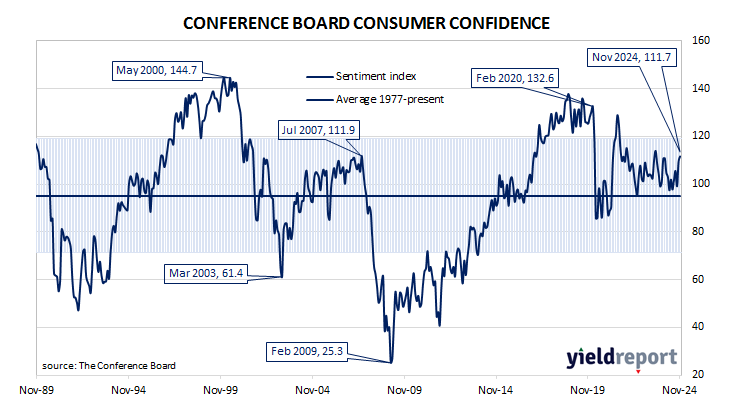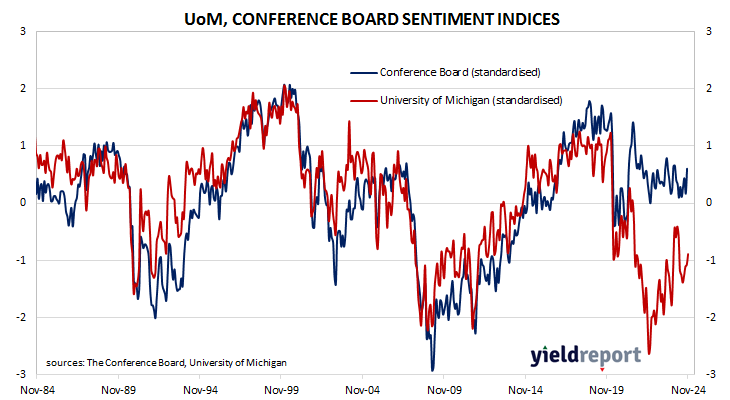Summary: Conference Board Consumer Confidence Index up in October, below expectations; index at top of range which has prevailed over past two years; short-term US Treasury yields decline, longer-term yield rise; expectations of Fed rate cuts largely unchanged, two more cuts priced in; views of present conditions, short-term outlook both improve; mainly driven by more positive consumer assessments of labour market.
US consumer confidence clawed its way back to neutral over the five years after the GFC in 2008/2009 and then went from strength to strength until late 2018. Measures of consumer confidence then oscillated within a relatively narrow band at historically high levels until they plunged in early 2020. Subsequent readings then fluctuated around the long-term average until March 2021 when they returned to elevated levels. However, a noticeable gap has since emerged between the two most-widely followed surveys.
The latest Conference Board survey completed in mid-November indicates its index of US consumer confidence has improved again, maintaining a level which is well above average. The latest reading of the Consumer Confidence Index registered 111.7 on a preliminary basis, slightly below the generally-expected figure of 112.5 but up from October’s final figure of 109.6.
“Consumer confidence continued to improve in November and reached the top of the range that has prevailed over the past two years,” said Dana Peterson, Chief Economist at The Conference Board.
Short-term US Treasury bond yields declined on the day while longer-term yields rose moderately. By the close of business, the 2-year Treasury bond yield had lost 2bps to 4.25%, the 10-year yield had gained 3bps to 4.30% while the 30-year yield finished 2bps higher at 4.47%.
In terms of US Fed policy, expectations of a lower federal funds rate in the next 12 months remained largely unchanged, with another two 25bp cuts currently factored in. At the close of business, contracts implied the effective federal funds rate would average 4.525% in December, 4.425% in January and 4.37% in February. October 2025 contracts implied 3.96%, 62bps less than the current rate.
Consumers’ views of present conditions and the near-future both improved. The Present Situation Index increased from October’s revised figure of 136.1 to 140.9 while the Expectations Index rose from 91.9 to 92.3.
“November’s increase was mainly driven by more positive consumer assessments of the present situation, particularly regarding the labour market,” Peterson added. “Compared to October, consumers were also substantially more optimistic about future job availability, which reached its highest level in almost three years. Meanwhile, consumers’ expectations about future business conditions were unchanged and they were slightly less positive about future income.”
The Consumer Confidence Survey is one of two widely followed monthly US consumer sentiment surveys which produce sentiment indices. The Conference Board’s index is based on perceptions of current business and employment conditions, as well as respondents’ expectations of conditions six months in the future. The other survey, conducted by the University of Michigan, is similar and it is used to produce an Index of Consumer Sentiment. That survey differs in that it does not ask respondents explicitly about their views of the labour market and it also includes some longer-term questions.



